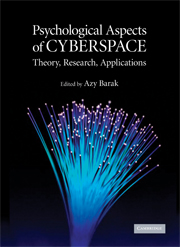Book contents
- Frontmatter
- Contents
- List of Tables
- List of Figures
- Preface
- List of Contributors
- 1 Reflections on the Psychology and Social Science of Cyberspace
- 2 Privacy, Trust, and Disclosure Online
- 3 Internet Abuse: Emerging Trends and Lingering Questions
- 4 Flow Experience in Cyberspace: Current Studies and Perspectives
- 5 Cybertherapeutic Theory and Techniques
- 6 Exposure in Cyberspace as Means of Enhancing Psychological Assessment
- 7 Down the Rabbit Hole: The Role of Place in the Initiation and Development of Online Relationships
- 8 The Sexy Side of the Internet: An Examination of Sexual Activities and Materials in Cyberspace
- 9 The Contact Hypothesis Reconsidered: Interacting via Internet: Theoretical and Practical Aspects
- 10 Influences on the Nature and Functioning of Online Groups
- 11 Online Motivational Factors: Incentives for Participation and Contribution in Wikipedia
- 12 How Internet-Mediated Research Changes Science
- Index
- References
9 - The Contact Hypothesis Reconsidered: Interacting via Internet: Theoretical and Practical Aspects
Published online by Cambridge University Press: 05 June 2012
- Frontmatter
- Contents
- List of Tables
- List of Figures
- Preface
- List of Contributors
- 1 Reflections on the Psychology and Social Science of Cyberspace
- 2 Privacy, Trust, and Disclosure Online
- 3 Internet Abuse: Emerging Trends and Lingering Questions
- 4 Flow Experience in Cyberspace: Current Studies and Perspectives
- 5 Cybertherapeutic Theory and Techniques
- 6 Exposure in Cyberspace as Means of Enhancing Psychological Assessment
- 7 Down the Rabbit Hole: The Role of Place in the Initiation and Development of Online Relationships
- 8 The Sexy Side of the Internet: An Examination of Sexual Activities and Materials in Cyberspace
- 9 The Contact Hypothesis Reconsidered: Interacting via Internet: Theoretical and Practical Aspects
- 10 Influences on the Nature and Functioning of Online Groups
- 11 Online Motivational Factors: Incentives for Participation and Contribution in Wikipedia
- 12 How Internet-Mediated Research Changes Science
- Index
- References
Summary
Intergroup conflict is sadly part of our existence. Such conflicts exist around the globe originating through differences, for example, in beliefs, religion, race, and culture. The degree of conflict between rival groups varies from mild hostility to all-out war, leading to the loss of thousands of lives every year. The field of intergroup conflict has attracted the attention of many social psychologists who have attempted to understand the phenomenon and to provide solutions to end it.
These scholars concentrated their research on the structure of such conflicts that they perceived as comprising three major aspects: cognitive, affective, and behavioral. The cognitive aspect is demonstrated by the stereotype held by one group toward the other; the affective aspect by the prejudice held regarding the other group, and the behavioral aspect by discrimination against this group.
The fundamental component found in intergroup conflict is the stereotype – the negative perception of the other group. Stereotypes may include negative perceptions of a variety of characteristics such as traits, physical characteristics, and expected behaviors. People generally believe that their group (the ingroup) is a heterogeneous group, whereas members of the other group (the outgroup) are all similar to one another. This perception, known as the homogeneity effect, is one of the bases for our tendency to stereotype the members of the outgroup and claim that they are all, for example, hostile, liars, and lazy (Linville, Fischer, & Salovey, 1989; Linville & Jones, 1980).
- Type
- Chapter
- Information
- Psychological Aspects of CyberspaceTheory, Research, Applications, pp. 209 - 227Publisher: Cambridge University PressPrint publication year: 2008
References
- 7
- Cited by



